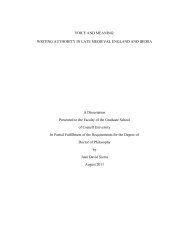Dissertation FINAL2.pdf - Cornell University
Dissertation FINAL2.pdf - Cornell University
Dissertation FINAL2.pdf - Cornell University
Create successful ePaper yourself
Turn your PDF publications into a flip-book with our unique Google optimized e-Paper software.
A clamor arises within the palace and the sound rolls about through the spacious<br />
atrium. Lighted lamps hang from the golden, fretted ceiling and torches conquer the<br />
night with flames.<br />
Like the heavenly bodies, the lychni, hanging from Dido’s golden, fretted ceiling of<br />
her palace (laquearibus), conquer the night with their flame. 91<br />
The comparison might<br />
be an idle one were Dido’s banqueting hall not the setting for the song of Iopas, 92<br />
whose subject matter includes the movements of the sun, the moon, and the stars<br />
(1.740-46). In an adaptation of this passage, Statius insists that the roof of Domitian’s<br />
palace might be mistaken for the laquearia of the gilded sky 93 (auratique putes<br />
laquearia caeli, 30-31). Both Virgil and Statius are drawing in turn upon a long<br />
tradition, possibly beginning with a passage from Ennius’ Andromache, according to<br />
which the sky is described through architectonic imagery and vice versa (92 Vahlen).<br />
The only other appearance of laqueare in the Aeneid occurs at the beginning of<br />
book 8: when Aeneas lies asleep on the banks of the Tiber, his troubled thoughts are<br />
compared to the light of the heavenly bodies reflected from a pail of water:<br />
sicut aquae tremulum labris ubi lumen aënis<br />
sole repercussum aut radiantis imagine lunae<br />
omnia peruolitat late loca, iamque sub auras<br />
erigitur summique ferit laquearia tecti.<br />
(8.22-25)<br />
91 Austin (1971) ad 727 observes that incensi “is a significant word; the lynchi did not merely hang<br />
down, but were lit.”<br />
92 Otis (1964) 240, however, plausibly maintains that the setting of the banquet is “a preparation for the<br />
flame-lit night of Troy’s destruction;” cf. Segal (1971) 345-46.<br />
93 Cf. also the palace of Sol at Ovid, Met. 2.1-30, with Brown (1987).<br />
68
















